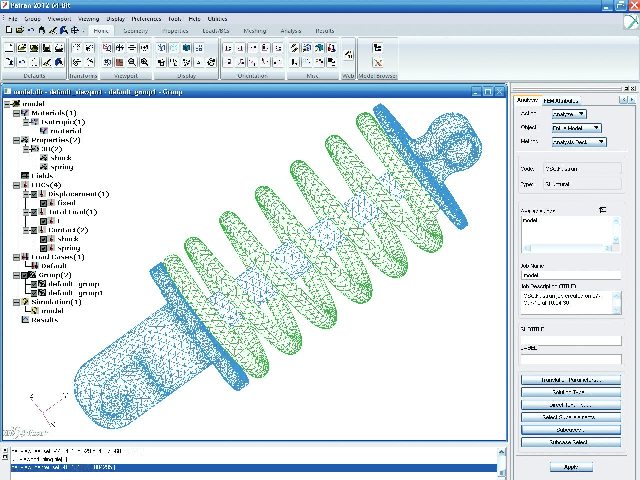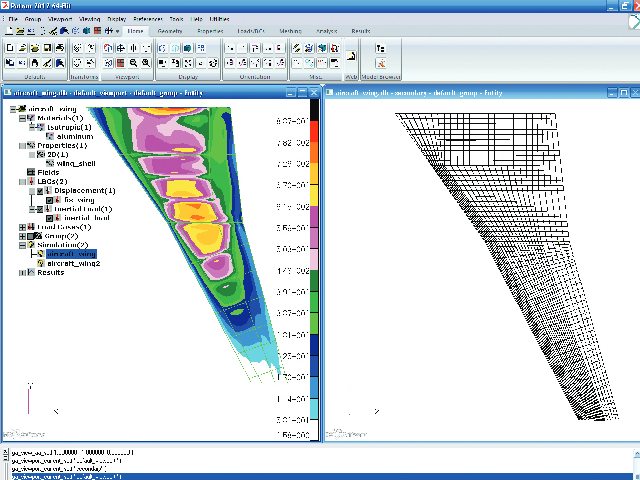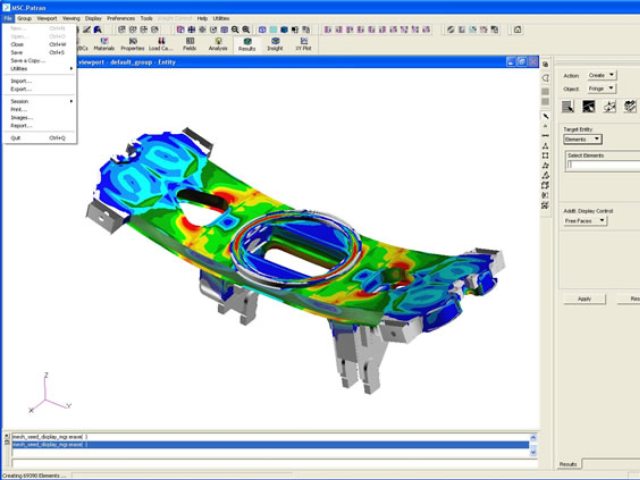Patran
Komplett FEA modelleringslösning
The industry’s leading finite element modeling environment
Patran is a comprehensive pre- and post-processing environment for FEA analysis

Patran är världens mest använda för- och efterbearbetningsprogram för finit elementanalys (FEA). Det tillhandahåller fastkroppsmodellering, modellering, analysuppsättning och efterbearbetning för flera lösare, inklusive MSC Nastran, Marc, Abaqus, LS-DYNA, ANSYS och Pam-Crash.
Patran erbjuder en rik uppsättning av verktyg som effektiviserar skapandet av analysklara modeller för linjära, icke-linjära, explicit dynamiska, termiska och andra finita elementlösningar. Patran gör det enkelt för vem som helst att skapa FE-modeller, från verktyg för rensning av geometrier som gör det enkelt för ingenjörer att hantera glipor och skrymslen i CAD till verktyg för fastkroppsmodellering som gör det möjligt att skapa modeller från grunden. Rutnät skapas enkelt på ytor och fasta kroppar med hjälp av helautomatiska rutnätsrutiner, manuella metoder som ger mer kontroll, eller kombinationer av båda. Slutligen är laster, gränsvillkor och analysinställningar för de flesta populära FE-lösarna inbyggda, vilket minimerar behovet av att redigera indatadäck.
Patrans omfattande och branschtestade funktioner säkerställer att er virtuella prototypframställning ger resultat snabbt så att ni kan utvärdera produktens prestanda mot kraven och optimera era konstruktioner.



-
Collateral
-
Avancerat geometriskt skapande, redigering och igenkänning av egenskaper

Patran innehåller en avancerad uppsättning verktyg för att skapa geometrier, utöver direkt CAD-åtkomst för att generera geometrier med finita elementmodeller.
Patran har också en sofistikerad funktion för detaljigenkänning som gör att användaren kan ta bort eller redigera hål, kilar och fasningar. För 3D-solidgeometri tillämpas befintliga rutnät och belastningar automatiskt på modellen igen efter att en ändring har gjorts i geometrin.
-
Stöd för multipel FEA-lösare

Patran is tailored to support both MSC Nastran and MD Nastran to enable the use of common finite element models and perform advanced engineering analysis and enhance designs using Nastran’s Design Optimization and Topology Optimization capabilities.
In addition to MSC Nastran, Patran also supports the other solvers developed by MSC (Marc, Dytran, and MSC Sinda) and also solvers like Abaqus, Ansys, LS-Dyna and Pamcrash, enabling you to stay in a single graphical user environment even if you have to use multiple solvers for various analyses.
-
Verktyg för efterbearbetning och rapportering för enkel utvärdering av resultat

Patran visar resultat för strukturella, termiska, utmattnings-, vätske-, magnetiska analyser eller i förhållande till någon annan tillämpning där de resulterande värdena associeras med sina respektive finita element eller noder. Avbildning omfattar hela den grafiska kapacitet som finns i Patran-produkten, inklusive grafisk skuggning och visuell verifiering före analys. Bildbehandlingen har ett antal alternativ som utnyttjar specialiserade maskinvarufunktioner, inklusive lokal vymanipulation, lokal skuggning, flera ljuskällor och transparens. Du kan även exportera bilder och filmer i många standardformat för att inkludera i dokument och webbaserade rapporter.
-
Patran kommandospråk

Patran Command Language (PCL) is the programming language at the heart of Patran. PCL is a high-level, block-structured language that provides many features found in traditional programming languages. It can be used to write application or site-specific commands and menus, perform variational modeling, and to more completely integrate with commercial or in-house software programs.
-
Patran kommandospråk
Q: Is Patran still being developed and supported?
A: Yes! Patran is currently on a bi-annual release cycle, with new capabilities and enhancements added every year. Recent releases have improved Patran’s user experience and expanded MSC Nastran support. No other software supports MSC Nastran pre- and post-processing capabilities as comprehensively as Patran.
Some of the latest MSC Nastran features supported in Patran include initial geometric imperfection buckling, nonlinear buckling, initial contact distance check, flexible glued contact, automatic contact generation, pyramid element creation and large rotation bolt modelling.
Q: Can I still buy Patran?
A: Yes, you can still buy Patran. Patran is available with either MSC One tokens or as a bundle with MSC Apex. With the combination of MSC Apex and Patran, you get the direct modelling capabilities of MSC Apex and Patran’s unparalleled support for MSC Nastran. You won’t miss out on any features, and you’ll be able to choose the best tools for your workflow.
Q: When should I use Patran over MSC Apex?
A: Both MSC Apex and Patran are powerful pre- and post-processors, but there are some circumstances where Patran truly excels. For example, if you’re using a solver other than MSC Nastran, you may find that Patran offers more processing capabilities.
Some capabilities of MSC Nastran are also only supported in Patran, such as aeroelasticity. MSC Apex supports MSC Nastran solutions 101, 103, 105, 111, and 400—for other MSC Nastran solutions, you may choose to construct the model (CAD-to-mesh) in MSC Apex, and then use Patran for the final attribution and solution setup.
You’ll want to use Patran when post-processing older models with results in XDB or master/dball formats. Patran is also the best tool for orphan mesh edits in typical aerospace global FEM models.
Patran is still the all-around best tool for post-processing MSC Nastran models. MSC Apex is continuously adding capabilities, but we offer both MSC Apex and Patran as a combination so you never miss out on features or capabilities.
Q: When should I use MSC Apex along with Patran?
A: MSC Apex is a powerful solution for moving from CAD to mesh. Whether you’re de-featuring, idealizing, or cleaning geometry, MSC Apex offers robust functionality. Direct model interaction along with automatic model updates makes MSC Apex the perfect choice for handling geometry and meshing.
Patran offers tools for transferring geometry and mesh from MSC Apex to Patran while maintaining associativity, making them a powerful duo when used together.
Q: Why should I update my older version of Patran to a newer version?
A: Patran gets better with every new version and includes more support for MSC Nastran. You may be missing out on these enhancements by not upgrading. In addition, if you’re using an older version of Patran and don’t have the Patran and MSC Apex combination, you might be limiting your modelling and meshing capabilities.
Q: What is the Patran Command Language (PCL)?
A: PCL is the Patran command language. PCL is very useful for automating workflows and processes in Patran. PCL can be used to create interactive forms, select items from the viewports, and perform other tasks to streamline your workflows.
Q: Does Patran only work with MSC Nastran?
A: Patran also works with other MSC solvers such as Dytran and Marc. In addition to seamless support for MSC Nastran, Marc, and Dytran, Patran also works with solvers such as Abaqus (Simulia) and Ansys.
Q: What solvers does Patran work best with?A: Patran is most powerful when used with MSC Nastran, but Patran also supports a wide range of solvers in addition to MSC Nastran.
Q: Why should I learn to use Patran?
A: Patran is the industry standard for many large aerospace OEMs for pre- and post-processing for MSC Nastran. Patran’s development team has worked closely with users over many years to help users develop efficient workflows.
Patran follows the development of MSC Nastran closely, meaning new capabilities in MSC Nastran are supported in Patran—sometimes before they’re supported in other software.
Q: I’m an aspiring FE analyst. Will I need to know how to use Patran as I start my career?
A: Patran is one of the most widely used pre- and post-processors in the world. Having experience with Patran may give you a head-start in your career. You will likely be expected to use the solution your organization works with, but because Patran is standard in many industries you will likely encounter it in your career.